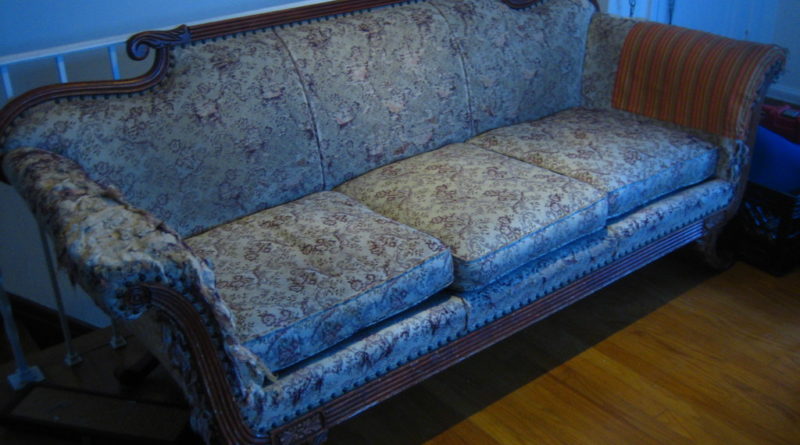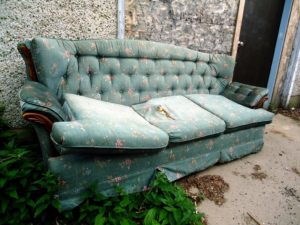How to Get Rid of a Sofa in the UK
Did you know that over 670,000 tonnes of furniture is discarded in the UK each year, with sofas being one of the most commonly thrown away items? If you’re part of this statistic and are looking to get rid of your old sofa, you’re in the right place. This comprehensive guide will walk you through the process of assessing your sofa’s current condition, preparing it for removal, and deciding on the best disposal method. Whether you’re considering selling, donating, recycling, or even removing it yourself, we’ve got you covered with tips and tricks to make the process as smooth as possible. We’ll also delve into the world of professional removal services, helping you understand what to look out for when hiring one. So, sit back (preferably not on your old sofa!) and let’s dive into the world of responsible and efficient sofa disposal.
1. Identifying the Current Condition of Your Sofa
Before you decide to get rid of your sofa, it’s crucial to assess its current condition. Is it still functional or completely worn out? The condition of your sofa will determine the best method to dispose of it. If it’s still in good shape, you might consider selling it or donating it to a charity. However, if it’s in poor condition, you might need to consider recycling or disposing of it in an environmentally friendly way.
When assessing the condition of your sofa, look out for signs of wear and tear such as sagging cushions, broken springs, or torn fabric. These signs indicate that your sofa might be beyond repair. Also, consider the age of your sofa. If it’s more than 10 years old, it might be time to replace it. In conclusion, identifying the current condition of your sofa is the first step in deciding the best way to get rid of it.
2. Preparing Your Sofa for Removal: Essential Steps
Getting rid of a sofa requires some preparation to ensure a smooth and efficient process. The first step is to measure the dimensions of your sofa. This is crucial as it helps you determine the best method of removal. If your sofa is too large to fit through your doors or hallways, you may need to disassemble it. Disassembling the sofa can be a complex task, especially if it’s an older model or if the construction is not immediately apparent. It’s recommended to refer to the manufacturer’s instructions or seek professional help if needed.
Once you’ve determined the size and whether disassembly is required, the next step is to remove any loose items from the sofa. This includes cushions, throws, and any other removable parts. It’s also important to clean the sofa before removal. This not only makes the process more pleasant but also reduces the chance of leaving behind any unwanted debris or stains. If you’re planning to donate or sell the sofa, a clean sofa is more likely to be accepted or purchased. Remember, the goal is to make the removal process as easy and efficient as possible.
3. Selling Your Old Sofa: Tips and Tricks
One of the most effective ways to get rid of an old sofa is by selling it. This not only helps in clearing up space in your home, but also provides an opportunity to earn some extra cash. However, selling a used sofa can be a daunting task if not done correctly. Understanding the market, setting a reasonable price, and presenting your sofa in the best light are crucial factors that can significantly influence the selling process.
When it comes to pricing your sofa, it’s essential to strike a balance between your expectations and the market standards. A comparison table can be a handy tool in this regard. For instance, a well-maintained leather sofa can fetch anywhere between £200 to £500, while a fabric sofa in good condition can be priced between £100 to £300. On the other hand, a sofa with visible signs of wear and tear might only attract offers around £50 to £100.
Type of Sofa | Condition | Price Range (£) |
|---|---|---|
Leather Sofa | Well-maintained | 200 – 500 |
Fabric Sofa | Good Condition | 100 – 300 |
Any Sofa | Visible Wear and Tear | 50 – 100 |
Remember, the key to selling your old sofa successfully is transparency and fair pricing. Always be honest about the condition of your sofa and set a price that reflects its value accurately. This will not only attract potential buyers but also ensure a smooth and satisfactory transaction for both parties.
4. Donating Your Sofa: Where and How?
Donating your old sofa can be a fantastic way to declutter your home while also making a positive impact. There are numerous charities and organisations that would be more than happy to take your unwanted furniture. Salvation Army, Goodwill, and Habitat for Humanity are just a few examples of places where you can donate your sofa. These organisations often offer free pick-up services, making the process even more convenient for you.
- Salvation Army: They accept furniture donations and offer free pick-up services.
- Goodwill: This organisation also accepts furniture donations, but pick-up services may vary by location.
- Habitat for Humanity: They accept gently used furniture and offer pick-up services through their ReStores.
When preparing your sofa for donation, it’s important to ensure it’s in good condition. Most organisations will not accept furniture that is torn, stained, or heavily worn. Cleaning your sofa and making any necessary minor repairs can increase the chances of your donation being accepted. Additionally, it’s worth noting that donating your sofa can often be used as a tax deduction, so be sure to ask for a receipt when you make your donation.
5. Recycling Your Sofa: An Eco-Friendly Option
Opting for recycling your old sofa is a responsible and eco-friendly way to dispose of it. This method not only helps in reducing landfill waste but also contributes to conserving natural resources. Many components of a sofa such as wood, metal, and foam can be recycled and used in the production of new items. However, it’s crucial to note that not all recycling centres accept sofas, so it’s advisable to contact your local recycling facility to check their policies.
While the pros of sofa recycling are numerous, including environmental conservation and potential cost savings, there are also a few cons to consider. The process can be time-consuming and may require some effort in terms of transporting the sofa to the recycling centre. Additionally, some centres may charge a fee for this service. Despite these challenges, the benefits of recycling your sofa far outweigh the drawbacks, making it a viable option for those looking to get rid of their old furniture in an eco-friendly manner.
6. Hiring Professional Sofa Removal Services: What to Consider
When it comes to disposing of your old sofa, hiring professional sofa removal services can be an excellent option. However, there are several factors to consider before making this decision. Firstly, it’s crucial to research the company’s reputation and customer reviews to ensure they provide reliable and efficient service. Secondly, consider the cost of the service. Prices can vary significantly between companies, so it’s worth getting a few quotes to find the best deal. Thirdly, it’s essential to check what the service includes. Some companies may offer to dispose of the sofa responsibly, while others may simply remove it from your property. Lastly, consider the convenience and time-saving benefits of using a professional service. Here’s a quick checklist to guide you through the process:
- Research the company’s reputation and reviews
- Compare prices between different services
- Check what the service includes
- Consider the convenience and time-saving benefits
7. DIY Sofa Removal: A Step-by-Step Guide
Embarking on a DIY sofa removal project can be a daunting task. However, with a clear plan and the right tools, it can be a manageable and even rewarding experience. Proper preparation is key to ensuring a smooth process. This includes gathering the necessary tools, such as a utility knife, a hammer, and a pry bar, as well as protective gear like gloves and safety glasses. It’s also crucial to have a clear idea of where the dismantled parts will go, whether it’s to a recycling centre, a charity, or the rubbish bin.
Now, let’s break down the process into manageable steps:
- Clear the area: Remove any objects around the sofa that could get in the way or be damaged during the process.
- Disassemble the sofa: Start by removing the cushions and pillows. Then, using your utility knife, carefully cut away the upholstery. Be sure to keep your hands and face protected to avoid injury.
- Separate the parts: Once the upholstery is removed, you’ll see the frame of the sofa. Use your hammer and pry bar to break it down into smaller, more manageable pieces.
- Dispose of the materials: Depending on the materials, some parts of the sofa may be recyclable, while others will need to be disposed of properly. Make sure to research local regulations and options for disposal.
Finally, it’s important to remember that while DIY sofa removal can be a cost-effective option, it’s not always the best choice for everyone. If the sofa is in good condition, consider donating it to a charity or selling it. If it’s too heavy or bulky for you to handle safely, or if you’re not comfortable using the necessary tools, it might be worth hiring a professional. Always prioritise safety and efficiency when deciding on the best method of sofa removal for your situation.


